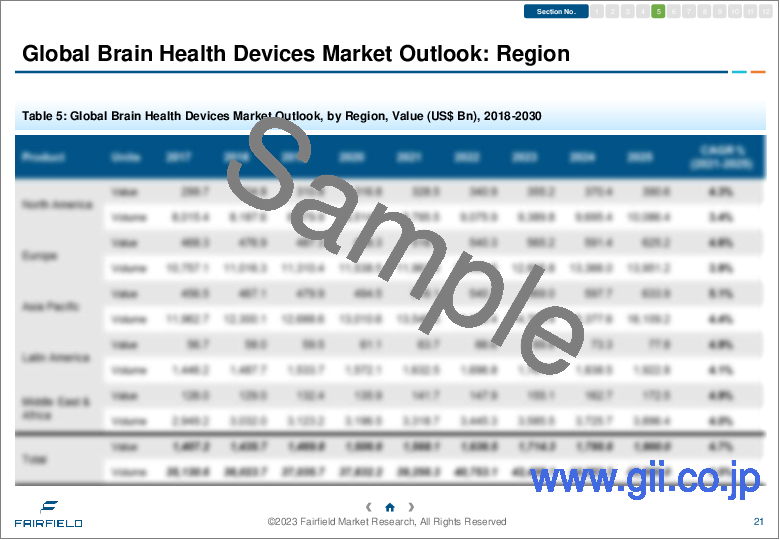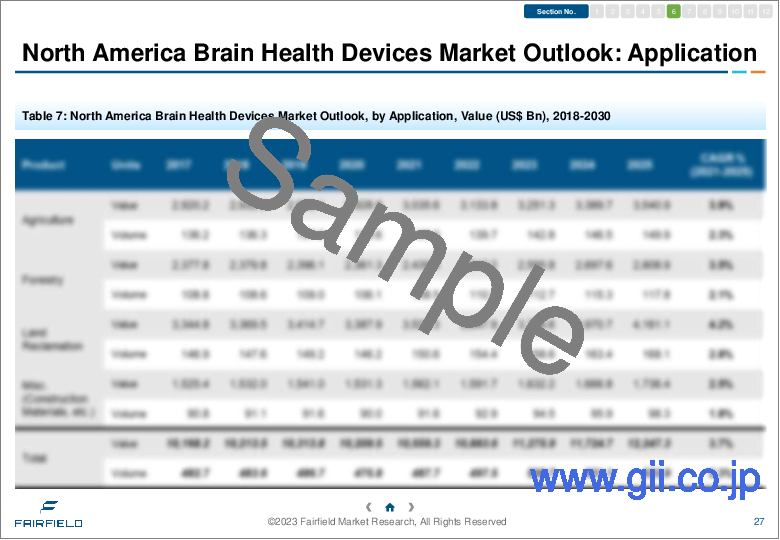|
|
市場調査レポート
商品コード
1312405
ブレインヘルスデバイス市場 - 世界の業界分析、規模、シェア、成長、動向、予測(2023年~2030年)- デバイス別、手技別、用途別、エンドユーザー別、地域別:(北米、欧州、アジア太平洋、ラテンアメリカ、中東・アフリカ)Brain Health Devices Market - Global Industry Analysis, Size, Share, Growth, Trends, & Forecast 2023-2030 - By Product, Technology, Grade, Application, End-user, Region: (North America, Europe, Asia Pacific, Latin America & Middle East & Africa) |
||||||
|
|||||||
| ブレインヘルスデバイス市場 - 世界の業界分析、規模、シェア、成長、動向、予測(2023年~2030年)- デバイス別、手技別、用途別、エンドユーザー別、地域別:(北米、欧州、アジア太平洋、ラテンアメリカ、中東・アフリカ) |
|
出版日: 2023年07月17日
発行: Fairfield Market Research
ページ情報: 英文 220 Pages
納期: 2~5営業日
|
- 全表示
- 概要
- 目次
当レポートでは、世界のブレインヘルスデバイス市場について調査し、市場の概要とともに、デバイス別、手技別、用途別、エンドユーザー別、地域別動向、および市場に参入する企業の競合動向などを提供しています。
目次
第1章 エグゼクティブサマリー
第2章 市場概要
- 市場の定義とセグメンテーション
- 市場力学
- 促進要因
- 抑制要因
- 市場機会マトリックス
- 規制シナリオ
- 比較分析:侵襲的vs非侵襲的、2022年
- 有望技術の将来分析
- COVID-19の影響分析
第3章 世界のブレインヘルスデバイス市場の見通し、2018年~2030年
- 世界のブレインヘルスデバイス市場の見通し、デバイス別、金額(100万米ドル)、2018年~2030年
- 世界のブレインヘルスデバイス市場の見通し、手技タイプ別、金額(100万米ドル)、2018年~2030年
- 世界のブレインヘルスデバイス市場の見通し、用途別、金額(100万米ドル)、2018年~2030年
- 世界のブレインヘルスデバイス市場の見通し、エンドユーザー別、金額(100万米ドル)、2018年~2030年
- 世界のブレインヘルスデバイス市場の見通し、地域別、金額(100万米ドル)、2018年~2030年
第4章 北米のブレインヘルスデバイス市場の見通し、2018年~2030年
第5章 欧州のブレインヘルスデバイス市場の見通し、2018年~2030年
第6章 アジア太平洋のブレインヘルスデバイス市場の見通し、2018年~2030年
第7章 その他の地域のブレインヘルスデバイス市場の見通し、2018年~2030年
第8章 競合情勢
- 企業の市場シェア分析
- 企業プロファイル
- Philips Healthcare
- GE Healthcare
- Medtronic
- Edwards Lifesciences Corporation
- Neurosoft
- Integra Lifesciences
- Neurolife
- Bioserenity
- Neuroelectrics
- Cognionics
第9章 付録
The brain health devices market has witnessed significant growth due to the increasing preference for minimally invasive procedures among patients. The market includes various devices such as magnetoencephalograms, electromyography (EMG) devices, deep brain stimulation systems (brain pacemaker), cerebral oximeters, and other implantable brain devices.
Speedy Regulatory Approvals Ensuring a Bright Future
The rapid advancements in neurodiagnostics are driving the growth of the brain health devices market. Patients are seeking early diagnosis of brain ailments to maximize the chances of successful treatment. Regulatory approvals granted to brain health devices play a vital role in fostering market growth. Notably, in 2019, the US Food and Drug Administration (FDA) granted approval to GE Healthcare for its deep learning apex tomography equipment. This transformative technology, known as deep learning image reconstruction (DLIR), uses a deep neural network (DNN) to create TrueFidelity CT scans.
Shift Towards Home Diagnosis Boosts Device Dominance
The trend towards early medical diagnosis in a home environment using wearable devices has led to devices dominating the product segment of the brain health devices market. This trend is expected to continue throughout the forecast period, driven by the increasing prevalence of various sleep, psychotic, neurological, and neurogenerative disorders.
North America Leads with Support from Cash-Rich Tech Giants
North America is projected to maintain its leadership in the brain health devices market, thanks to the presence of several global tech giants. Companies like Microsoft and Google are spearheading change with significant investments in wearables. The Asia Pacific (APAC) region is also poised for growth as emerging economies invest substantial sums in manufacturing brain dysfunction management devices. India, in particular, already has the second-highest global incidence rate of dementia, making it a promising market for brain health devices.
Prohibitive Cost Restricts Mass Adoption
While brain health devices offer promising benefits, their prohibitive cost poses a challenge for small healthcare providers and clinics to adopt them. As a result, hospitals, with their larger patient footfall and resources, remain the largest users of brain monitoring devices. Hospitals have the necessary trained medical personnel to effectively operate brain health devices, further driving their adoption.
Companies Leading Innovation in the Brain Health Devices Market
Neurotechnological innovation is advancing rapidly in the brain health devices market, making devices readily available. Initiatives like the BRAIN initiative in 2013 have contributed to R&D efforts related to brain function. In 2019, Masimo received CE Mark authorization for its SedLine brain function monitor for children. Other prominent companies in the brain health devices market include Advanced Brain Monitoring Inc., CAS Medical Systems Inc., Covidien PLC, Cadwell Laboratories Inc., Elekta AB, GE Healthcare, Integra LifeSciences Holdings Corporation, Natus Medical Inc., NeuroWave Systems Inc., Nihon Kohden Corporation, Philips Healthcare, and Siemens Healthineers.
Table of Contents
1. Executive Summary
- 1.1. Global Brain Health Devices Market Outlook, 2018 - 2030 (US$ Million)
- 1.2. Global Brain Health Devices Market Incremental Opportunity, 2018 - 2030 (US$ Million)
- 1.3. Key Industry Trends
2. Market Overview
- 2.1. Market Definitions and Segmentations
- 2.2. Market Dynamics
- 2.2.1. Drivers
- 2.2.1.1. Driver 1
- 2.2.1.2. Driver 2
- 2.2.2. Restraints
- 2.2.2.1. Restraint 1
- 2.2.2.2. Restraint 2
- 2.2.3. Market Opportunities Matrix
- 2.2.1. Drivers
- 2.3. Regulatory Scenario
- 2.4. Comparative analysis: Invasive vs Non-invasive, Value %, 2022
- 2.5. Promising Technology Future Analysis
- 2.5.1. Wearable MRI
- 2.5.2. MagnetoEG
- 2.5.3. Others
- 2.6. Covid-19 Impact Analysis
3. Global Brain Health Devices Market Outlook, 2018 - 2030
- 3.1. Global Brain Health Devices Market Outlook, by Device, Value (US$ Mn), 2018 - 2030
- 3.1.1. Key Highlights
- 3.1.1.1. Cerebral oximeters
- 3.1.1.2. Electroencephalogram (EEG)
- 3.1.1.3. MRI
- 3.1.1.4. CT Scan
- 3.1.1.5. PET Scan
- 3.1.1.6. Electromyography devices
- 3.1.1.7. Intracranial pressure Monitoring Devices
- 3.1.1.8. Magnetoencephalography Device
- 3.1.1.9. Others (Transcranial doppler ultrasound)
- 3.1.2. BPS Analysis/Market Attractiveness Analysis
- 3.1.1. Key Highlights
- 3.2. Global Brain Health Devices Market Outlook, by Procedure Type, Value (US$ Mn), 2018 - 2030
- 3.2.1. Key Highlights
- 3.2.1.1. Invasive Devices
- 3.2.1.2. Non-invasive Devices
- 3.2.2. BPS Analysis/Market Attractiveness Analysis
- 3.2.1. Key Highlights
- 3.3. Global Brain Health Devices Market Outlook, by Application, Value (US$ Mn), 2018 - 2030
- 3.3.1. Key Highlights
- 3.3.1.1. Sleep Disorders
- 3.3.1.2. Accidental Injuries
- 3.3.1.3. Alzheimer's Disease
- 3.3.1.4. Epilepsy
- 3.3.1.5. Others
- 3.3.2. BPS Analysis/Market Attractiveness Analysis
- 3.3.1. Key Highlights
- 3.4. Global Brain Health Devices Market Outlook, by End User, Value (US$ Mn), 2018 - 2030
- 3.4.1. Key Highlights
- 3.4.1.1. Hospitals and Clinics
- 3.4.1.2. Diagnostic Imaging Centers
- 3.4.1.3. Homecare settings
- 3.4.1.4. Assisted Living Facilities
- 3.4.1.5. Others
- 3.4.2. BPS Analysis/Market Attractiveness Analysis
- 3.4.1. Key Highlights
- 3.5. Global Brain Health Devices Market Outlook, by Region, Value (US$ Mn), 2018 - 2030
- 3.5.1. Key Highlights
- 3.5.1.1. North America
- 3.5.1.2. Europe
- 3.5.1.3. Asia Pacific
- 3.5.1.4. Rest of the World
- 3.5.2. BPS Analysis/Market Attractiveness Analysis
- 3.5.1. Key Highlights
4. North America Brain Health Devices Market Outlook, 2018 - 2030
- 4.1. North America Brain Health Devices Market Outlook, by Device Type, Value (US$ Mn), 2018 - 2030
- 4.1.1. Key Highlights
- 4.1.1.1. Cerebral oximeters
- 4.1.1.2. Electroencephalogram (EEG)
- 4.1.1.3. MRI
- 4.1.1.4. CT Scan
- 4.1.1.5. PET Scan
- 4.1.1.6. Electromyography devices
- 4.1.1.7. Intracranial pressure Monitoring Devices
- 4.1.1.8. Magnetoencephalography Device
- 4.1.1.9. Others (Transcranial doppler ultrasound)
- 4.1.2. BPS Analysis/Market Attractiveness Analysis
- 4.1.1. Key Highlights
- 4.2. North America Brain Health Devices Market Outlook, by Procedure Type, Value (US$ Mn), 2018 - 2030
- 4.2.1. Key Highlights
- 4.2.1.1. Invasive Devices
- 4.2.1.2. Non-invasive Devices
- 4.2.2. BPS Analysis/Market Attractiveness Analysis
- 4.2.1. Key Highlights
- 4.3. North America Brain Health Devices Market Outlook, by Application, Value (US$ Mn), 2018 - 2030
- 4.3.1. Key Highlights
- 4.3.1.1. Sleep Disorders
- 4.3.1.2. Accidental Injuries
- 4.3.1.3. Alzheimer's Disease
- 4.3.1.4. Epilepsy
- 4.3.1.5. Others
- 4.3.2. BPS Analysis/Market Attractiveness Analysis
- 4.3.1. Key Highlights
- 4.4. North America Brain Health Devices Market Outlook, by End User, Value (US$ Mn), 2018 - 2030
- 4.4.1. Key Highlights
- 4.4.1.1. Hospitals and Clinics
- 4.4.1.2. Diagnostic Imaging Centers
- 4.4.1.3. Homecare settings
- 4.4.1.4. Assisted Living Facilities
- 4.4.1.5. Others
- 4.4.2. BPS Analysis/Market Attractiveness Analysis
- 4.4.1. Key Highlights
- 4.5. North America Brain Health Devices Market Outlook, by Country, Value (US$ Mn), 2018 - 2030
- 4.5.1. Key Highlights
- 4.5.1.1. U.S.
- 4.5.1.2. Canada
- 4.5.2. BPS Analysis/Market Attractiveness Analysis
- 4.5.1. Key Highlights
5. Europe Brain Health Devices Market Outlook, 2018 - 2030
- 5.1. Europe Brain Health Devices Market Outlook, by Device Type, Value (US$ Mn), 2018 - 2030
- 5.1.1. Key Highlights
- 5.1.1.1. Cerebral oximeters
- 5.1.1.2. Electroencephalogram (EEG)
- 5.1.1.3. MRI
- 5.1.1.4. CT Scan
- 5.1.1.5. PET Scan
- 5.1.1.6. Electromyography devices
- 5.1.1.7. Intracranial pressure Monitoring Devices
- 5.1.1.8. Magnetoencephalography Device
- 5.1.1.9. Others (Transcranial doppler ultrasound)
- 5.1.2. BPS Analysis/Market Attractiveness Analysis
- 5.1.1. Key Highlights
- 5.2. Europe Brain Health Devices Market Outlook, by Procedure Type, Value (US$ Mn), 2018 - 2030
- 5.2.1. Key Highlights
- 5.2.1.1. Invasive Devices
- 5.2.1.2. Non-invasive Devices
- 5.2.2. BPS Analysis/Market Attractiveness Analysis
- 5.2.1. Key Highlights
- 5.3. Europe Brain Health Devices Market Outlook, by Application, Value (US$ Mn), 2018 - 2030
- 5.3.1. Key Highlights
- 5.3.1.1. Sleep Disorders
- 5.3.1.2. Accidental Injuries
- 5.3.1.3. Alzheimer's Disease
- 5.3.1.4. Epilepsy
- 5.3.1.5. Others
- 5.3.2. BPS Analysis/Market Attractiveness Analysis
- 5.3.1. Key Highlights
- 5.4. Europe Brain Health Devices Market Outlook, by End User, Value (US$ Mn), 2018 - 2030
- 5.4.1. Key Highlights
- 5.4.1.1. Hospitals and Clinics
- 5.4.1.2. Diagnostic Imaging Centers
- 5.4.1.3. Homecare settings
- 5.4.1.4. Assisted Living Facilities
- 5.4.1.5. Others
- 5.4.2. BPS Analysis/Market Attractiveness Analysis
- 5.4.1. Key Highlights
- 5.5. Europe Brain Health Devices Market Outlook, by Country, Value (US$ Mn), 2018 - 2030
- 5.5.1. Key Highlights
- 5.5.1.1. Germany
- 5.5.1.2. France
- 5.5.1.3. U.K.
- 5.5.1.4. Italy
- 5.5.1.5. Spain
- 5.5.1.6. Rest of Europe
- 5.5.2. BPS Analysis/Market Attractiveness Analysis
- 5.5.1. Key Highlights
6. Asia Pacific Brain Health Devices Market Outlook, 2018 - 2030
- 6.1. Asia Pacific Brain Health Devices Market Outlook, by Device Type, Value (US$ Mn), 2018 - 2030
- 6.1.1. Key Highlights
- 6.1.1.1. Cerebral oximeters
- 6.1.1.2. Electroencephalogram (EEG)
- 6.1.1.3. MRI
- 6.1.1.4. CT Scan
- 6.1.1.5. PET Scan
- 6.1.1.6. Electromyography devices
- 6.1.1.7. Intracranial pressure Monitoring Devices
- 6.1.1.8. Magnetoencephalography Device
- 6.1.1.9. Others (Transcranial doppler ultrasound)
- 6.1.2. BPS Analysis/Market Attractiveness Analysis
- 6.1.1. Key Highlights
- 6.2. Asia Pacific Brain Health Devices Market Outlook, by Procedure Type, Value (US$ Mn), 2018 - 2030
- 6.2.1. Key Highlights
- 6.2.1.1. Invasive Devices
- 6.2.1.2. Non-invasive Devices
- 6.2.2. BPS Analysis/Market Attractiveness Analysis
- 6.2.1. Key Highlights
- 6.3. Asia Pacific Brain Health Devices Market Outlook, by Application, Value (US$ Mn), 2018 - 2030
- 6.3.1. Key Highlights
- 6.3.1.1. Sleep Disorders
- 6.3.1.2. Accidental Injuries
- 6.3.1.3. Alzheimer's Disease
- 6.3.1.4. Epilepsy
- 6.3.1.5. Others
- 6.3.2. BPS Analysis/Market Attractiveness Analysis
- 6.3.1. Key Highlights
- 6.4. Asia Pacific Brain Health Devices Market Outlook, by End User, Value (US$ Mn), 2018 - 2030
- 6.4.1. Key Highlights
- 6.4.1.1. Hospitals and Clinics
- 6.4.1.2. Diagnostic Imaging Centers
- 6.4.1.3. Homecare settings
- 6.4.1.4. Assisted Living Facilities
- 6.4.1.5. Others
- 6.4.2. BPS Analysis/Market Attractiveness Analysis
- 6.4.1. Key Highlights
- 6.5. Asia Pacific Brain Health Devices Market Outlook, by Country, Value (US$ Mn), 2018 - 2030
- 6.5.1. Key Highlights
- 6.5.1.1. China
- 6.5.1.2. Japan
- 6.5.1.3. India
- 6.5.1.4. Australia & New Zealand
- 6.5.1.5. Rest of Asia Pacific
- 6.5.2. BPS Analysis/Market Attractiveness Analysis
- 6.5.1. Key Highlights
7. Rest of the World Brain Health Devices Market Outlook, 2018 - 2030
- 7.1. Rest of the World Brain Health Devices Market Outlook, by Device Type, Value (US$ Mn), 2018 - 2030
- 7.1.1. Key Highlights
- 7.1.1.1. Cerebral oximeters
- 7.1.1.2. Electroencephalogram (EEG)
- 7.1.1.3. MRI
- 7.1.1.4. CT Scan
- 7.1.1.5. PET Scan
- 7.1.1.6. Electromyography devices
- 7.1.1.7. Intracranial pressure Monitoring Devices
- 7.1.1.8. Magnetoencephalography Device
- 7.1.1.9. Others (Transcranial doppler ultrasound)
- 7.1.2. BPS Analysis/Market Attractiveness Analysis
- 7.1.1. Key Highlights
- 7.2. Rest of the World Brain Health Devices Market Outlook, by Procedure Type, Value (US$ Mn), 2018 - 2030
- 7.2.1. Key Highlights
- 7.2.1.1. Invasive Devices
- 7.2.1.2. Non-invasive Devices
- 7.2.2. BPS Analysis/Market Attractiveness Analysis
- 7.2.1. Key Highlights
- 7.3. Rest of the World Brain Health Devices Market Outlook, by Application, Value (US$ Mn), 2018 - 2030
- 7.3.1. Key Highlights
- 7.3.1.1. Sleep Disorders
- 7.3.1.2. Accidental Injuries
- 7.3.1.3. Alzheimer's Disease
- 7.3.1.4. Epilepsy
- 7.3.1.5. Others
- 7.3.2. BPS Analysis/Market Attractiveness Analysis
- 7.3.1. Key Highlights
- 7.4. Rest of the World Brain Health Devices Market Outlook, by End User, Value (US$ Mn), 2018 - 2030
- 7.4.1. Key Highlights
- 7.4.1.1. Hospitals and Clinics
- 7.4.1.2. Diagnostic Imaging Centers
- 7.4.1.3. Homecare settings
- 7.4.1.4. Assisted Living Facilities
- 7.4.1.5. Others
- 7.4.2. BPS Analysis/Market Attractiveness Analysis
- 7.4.1. Key Highlights
- 7.5. Rest of the World Brain Health Devices Market Outlook, by Country, Value (US$ Mn), 2018 - 2030
- 7.5.1. Key Highlights
- 7.5.1.1. Latin America
- 7.5.1.2. Middle East & Africa
- 7.5.1.3. Rest of Rest of the World
- 7.5.2. BPS Analysis/Market Attractiveness Analysis
- 7.5.1. Key Highlights
8. Competitive Landscape
- 8.1. Company Market Share Analysis
- 8.2. Company Profiles
- 8.2.1. Philips Healthcare
- 8.2.1.1. Company Overview
- 8.2.1.2. Financial Overview
- 8.2.1.3. Product Pipeline
- 8.2.1.4. Recent Developments
- 8.2.2. GE Healthcare
- 8.2.3. Medtronic
- 8.2.4. Edwards Lifesciences Corporation
- 8.2.5. Neurosoft
- 8.2.6. Integra Lifesciences
- 8.2.7. Neurolife
- 8.2.8. Bioserenity
- 8.2.9. Neuroelectrics
- 8.2.10. Cognionics
- 8.2.1. Philips Healthcare
9. Appendix
- 9.1. Research Methodology
- 9.2. Report Assumptions
- 9.3. Acronyms and Abbreviations





